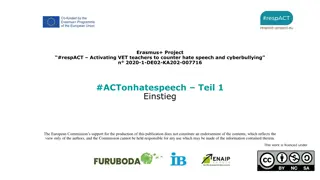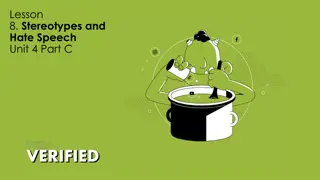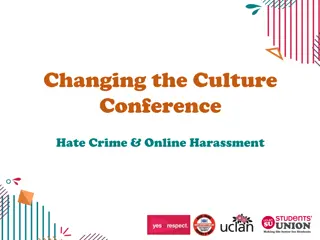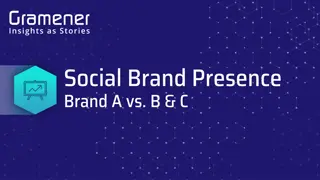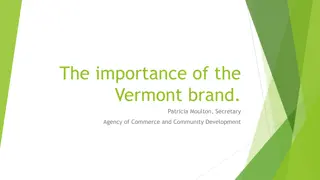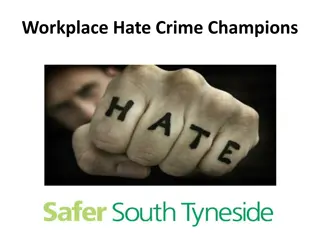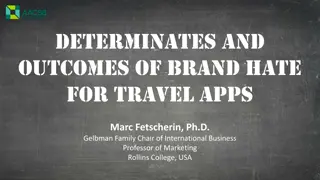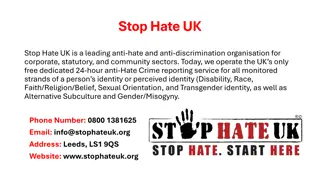Brand Hate: Moderating Role of Individual Variables
Hate encompasses diverse emotions and behaviors, particularly in interpersonal and brand contexts. This research delves into the theoretical framework of hate in psychology, transitioning from interpersonal hate to brand hate. Discover the intense negative emotions and detachment consumers experience towards brands, exploring active and passive hate dimensions with various emotional items. The goal is to understand brand hate's impact on consumer-brand relationships and behaviors.
Uploaded on Feb 17, 2025 | 0 Views
Download Presentation

Please find below an Image/Link to download the presentation.
The content on the website is provided AS IS for your information and personal use only. It may not be sold, licensed, or shared on other websites without obtaining consent from the author.If you encounter any issues during the download, it is possible that the publisher has removed the file from their server.
You are allowed to download the files provided on this website for personal or commercial use, subject to the condition that they are used lawfully. All files are the property of their respective owners.
The content on the website is provided AS IS for your information and personal use only. It may not be sold, licensed, or shared on other websites without obtaining consent from the author.
E N D
Presentation Transcript
BRAND HATE: MODERATING ROLE OF INDIVIDUAL VARIABLES 6th International Consumer Brand Relationship Conference Canc n, Mexico 19-21 may 2019 Am lie Bottin 1 L restc Marseille, France
Research context 2 2
Theoretical framework: Hate in psychology and philosophy Interpersonal hate Consist of several emotions Specific characteristics Generate a behavior Izard 1977 Angry Storm & Storm 1987 Fitness & Fletcher 1993 Angry McDougall 2001 Angry Fear Disgust Sternberg 2003 Angry Fear Disgust Contempt Disgust Contempt Disgust Contempt Revulsion Repugnance Composition of hate An Emotion (Allport, 1979) or a Feeling (Sonnemans and Frijda, 1994) 3
Theoretical framework: Hate in psychology and philosophy Interpersonal hate Consist of several emotions Specific characteristics Generate a behavior A Stable and durable concept (Dovidio et al., 2008) It Stops if the target disappears (Litwinski, 1945) Hate does not focus on details (Ben-Ze'ev, 2001) The other has fundamentally bad characteristics Haunting (Loncan, 2013; Schonewolf, 1996) 4
Theoretical framework: Hate in psychology and philosophy Interpersonal hate Consist of several emotions Specific characteristcs Generate a behavior Targets Final goals To destroy Individuals To hurt To verbally assault Material goods To escape 5
Theoretical framework: From hate to brand hate Interpersonal hate Consist of several emotions Brand hate Belongs to the brand dislike (Romani et al. 2012) Is assimilated to the desire for revenge and avoidance (Gr goire et al. 2009) Definition intense negative emotional affect towards the brand (Bryson et al. 2010, p.395) consumers detachment from a brand and its associations as a result of consumers intense and deeply held negative emotions such as disgust, anger, contempt, devaluation and diminution Kucuk (2016, p.19) Conceptualization and Measure 2 dimensions (active and passive hate), 6 factors and 18 emotional items(Zarantonello et al. 2016) 5 types of brand hate: Cool, Hot, Simmering, Burning and Seething (Fetscherin, 2019; Kucuk, 2018;) based on Sternberg s triangular theory of hate (2003, 2005) and 3 emotions: Disgust, Contempt and Anger Specific characteristcs Generate a behavior Brand hate is only considered in its emotional aspects No consideration of its characteristics: its sustainability and the obsession for the object of the hate 6
Theoretical framework: Brand hate Determinants Brand s country of origin, consumer dissatisfaction, negative stereotypes of a brand s consumers, and corporate social performance (Bryson et al. 2013). Negative past experience, symbolic incongruence, and ideological incompatibility (Hegner et al. 2017). Consequences Protest, complaining, negative word-of-mouth, patronage reduction (Zarantonello et al., 2016). Brand avoidance, negative WOM, brand retaliation (Hegner et al., 2017). Brand switching, WFS, private complaining, brand revenge, brand retaliation, public complaining (Fetscherin, 2019). Individuals variables Personality traits (big five) link with levels of brand hate (Kucuk, 2018). 7
Research questions and objectives Research questions How to measure brand hate? Which individual variables influence brand hate and the brand haters behaviors? Research objectives To develop a valid and reliable scale of Brand hate To investigate the moderating role of individual variables: Locus of control, Self-esteem and Consumer propensity to resist in the relationship between negative brand attitude and brand hate, and between brand hate and two behavioral variables: negative word-of- mouth and brand avoidance. 8
Methodology Study Sample 15 semi-directives interviews 3138 observations (internet forums) 93 respondents of prototypical approach (Fehr, 1986) Objectives S1 To generate items for the scale To purify items and to establish the scale factorial structure To confirm the scale factorial structure and to control the scale validity and reliability To test the conceptual model and the moderators influence S2 N=553 (SPSS) S3 N=332 (AMOS) S4 N=548 (XLSTAT) 9
Study 1, 2 and 3: Scale creation 62 items 5 factors 23 items 5 factors 18 items This brand makes me sick This brand is disgusting I feel disgust against this brand I feel repulsion against this brand This brand is horrible Study 1 Enmity Qualitative data Study 2 EFA Study 3 CFA Validity assessed: Reliability: J reskog s Rh >0,844 Convergent validity: Rh VC>0,620 This brand haunts my everyday life I have unpleased physical manifestations when I think to this brand I feel stressed when I feel to this brand Obsession Internal discriminant validity External discriminant validity Brand distrust (Cho, 2006) Brand trust (Gurviez & Korchia, 2002) I feel tormented by this brand I lose control of my negative feelings whan I think to this brand This marque is the wrong This brand is the absolute evil This brand is scary I am upset against this brand I am more upset than ever against this brand I am mad at this brand Predictive validity Consumer retaliation (Huefner & Hunt, 2000) R =11,2% Intent to boycott (Capelli et al., 2002) R =6,6% Fear Agressivity Fit indices 2=232,466, dl=127, p=,000, Normed 2=1,83, GFI=,929, TLI=,970, CFI=,975, RMSEA=,050, SRMR=,0476, NFI=,947 What I feel for this brand is violent, in a negative way I have very violent feelings against this brand Violence
Study 4: Research model Positive relation Negative relation Banikema & Roux, 2014 2 factors 7 items Levenson, 1973 24 items Consumer propensity to resist H13 - Internal locus of control External locus of control Romani & al. 2012 3 items Park et al, 2010 2 factors 8 items H12 + Negative word-of- mouth H4 + H3 - Negative brand attitude (Strength*Valenc e) H6 + H1 + Brand hate H8 + Brand avoidance 5 factors 18 items Khan, 2012 3 items H10 + H11 - Self- esteem Rosenberg, 1979 10 items 11
Study 4: Results Most quoted brands N=548 139 brand quoted at least one time x25 x22 x37 x8 x7 x12 x11 x6 x6 x7 x7 x7 x6 12
Study 4: Results Positive relation Negative relation Consumer propensity to resist External locus of control Internal locus of control ** 5% *** 1% -,109*** -,176*** Negative WOM -,153*** ,141*** ,474*** Negative brand attitude (Strenght*Valence) Brand hate ,245*** Brand avoidance ,317*** Fear Obsession -,134*** Violence Enmity Agressivity ,091** n=548 PLS-PM: XLSTAT Self- esteem 13
Findings Theoretical contributions A brand hate scale for the French context: 2 news dimensions: Obsession and Violence A new antecedent: Negative Brand Attitude Confirmation of previous results: Brand hate involves a consumer reaction (Fetscherin, 2019; Hegner et al., 2017; Zarantonello et al., 2016). Moderator role of 3 individuals characteristics: LOC, Self-esteem and CPR A consumer with a negative brand attitude is more likely to feel hate, rejecting the fault of these feelings on others (external LOC) A consumer with a strong self-esteem doesn t flee the brand he/she hates, but rather faces it An unexpected result: the hater consumer s with a propensity to resist doesn t have NWOM behavior Managerial implications Each brand can measure the hate that consumers feel against them and view the most important dimension for it The individual characteristics change the behaviors of the brand haters: 14
Limitations & Future research Limitations Exclusion of the group s effect on brand hate Difficulty to differentiate Brand hate and Product hate A static approach Need a lot of respondents to have Brand haters Future research To study brand hate in a dynamic perspective (longitudinal study) To explore Brand hate across cultures To test others moderators (psychological reactance or regulatory focus) with more antecedents and consequences To focus more on studying consumer propensity to resist 15
THANK YOU FOR YOUR ATTENTION 16
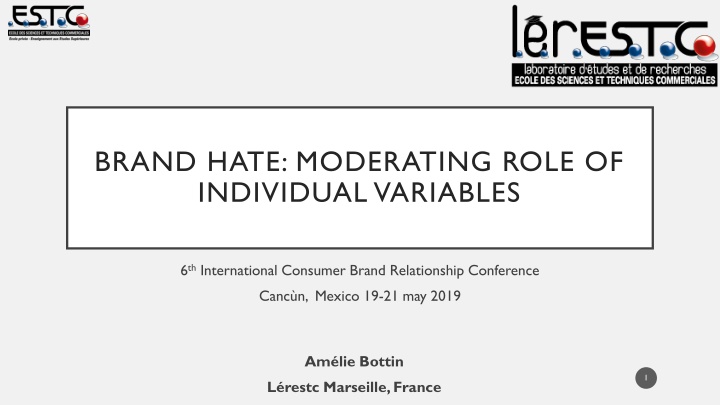

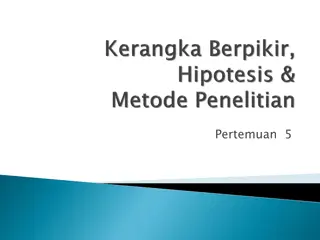
![Prevention and Combating of Hate Crimes and Hate Speech Bill [B.9B.2018]](/thumb/60513/prevention-and-combating-of-hate-crimes-and-hate-speech-bill-b-9b-2018.jpg)
